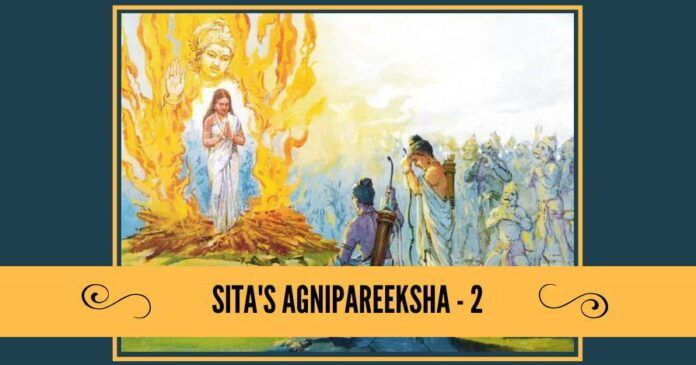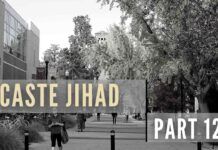
Part 1 of this series can be ‘accessed ‘ here. This is Part 2.
If he was Maryada Purushottam, then his wife definitely had to be a dharmacharini
Rama knew therefore that this wound had to be healed. After the war with Ravana was over and he lay dead on the battleground, Rama began heaping insults on Sita, similar to the ones she heaped on Lakshmana. He spoke to her in very harsh language asking whether she could be chaste after all this time in Ravana’s custody. He asked her to take Lakshmana or Bharata or indeed even Shatrugna or Sugreeva or Vibhishana for a husband after this long period of imprisonment in another man’s abode.
These words seared into Sita and she obviously felt all the anger and humiliation that Lakshmana would have felt on hearing her own allegations against him that fateful day in the forest. The only difference was that Lakshmana’s shaming was in private where only she and he were aware of what she had said whereas in Sita’s case, she was publicly being humiliated. Even this seems deliberate because by shaming her in public, Rama is evoking the sympathies of Lakshmana and indeed of all present there, for his wife, for that is the inherent nature of people.
Someone who is looked upon as an underdog will always evoke the sympathy of the majority even though their actions might have been wrong in the first place. Swamiji explains that Sita, overcome by anger and mortification at the accusations thrown by Rama says that she will walk into a pyre to prove her innocence. Later, Rishi Valmiki in his elaborate retelling of the story, says that Sita asked Lakshmana to prepare the pyre for her and Lakshmana looked angrily at Rama hoping that he would not allow it to happen.
However, Rama firm in his stance refused to stop Lakshmana to do the bidding of his wife and allowed Sita to carry through with her threat. How poetic it is that Sita is made to reap the fruits of her karma by the same person who she insulted in the first place. And all this without Rama ever bringing to all who were gathered there on that battleground, the event that had transpired earlier. Only Rama knew what he was up to. He was upholding two facets of dharma here. He was rightfully defending his brother and he did not allow his love for his wife to cloud his judgment on how a wrong perpetrated on his brother could be set right. Moreover, as the leader of the winning side in the war, he was setting an example of how righteous a leader should be. He was establishing his commitment to rajadharma by subjecting his wife to such an ordeal since a part of the crowd would only be assuaged if they knew that Sita was chaste. He underlined that as a king, he would not demand a lesser standard of his wife that he would demand of anyone else. If he was Maryada Purushottam, then his wife definitely had to be a dharmacharini and as long as the public gaze was suspicious, she would never be able to claim that title.
Agni in sanatana dharma signifies purity. It is no wonder that Sita entered the fire and returned from it purified and not carrying the baggage of any of the karma from her previous actions. She is now ready to be identified as the embodiment of dharma. If there was no avenue for her to neutralize the effects of the bad karma she had accumulated with her treatment of Lakshmana, she would not be satisfying the conditions to be a dharmacharini.
Dharma and karma are beautifully woven into the Ramayana narrative and one realizes that silly interpretations using superficial and inadequate fancy theories imported from the West are no match for the lessons of dharma that our hallowed texts teach.
There is another version for the agnipareeksha of Sita and this is taken from the Adhyatma Ramayana which is a retelling of the story to underline its spiritual meanings. These meanings are to be used for one’s spiritual progress. Again, it is important to remember that the spiritual meaning of the text does not distort one bit the adherence of the text to the tenets of our shruti, the Vedas.
In the Adhyatma Ramayana, the ultimate purpose of Ramavatara, the manifestation of the supreme as Lord Rama, is for the killing of Ravana. In the ashrama in Panchavati, Rama knows that Ravana would be coming in search of Sita and thus he orders Sita to stay away from him by taking refuge in the fire for a year till completion of HIS mission to kill Ravana. Sita, doing his bidding, takes refuge in the fire at the ashrama and an illusory or Maya form of herself is brought forth when Ravana comes to abduct her. Later, after the war is over, Rama has to tell the Maya Sita that her role is over and that she needs to give space to the real Sita. Thus, it is that Maya Sita who undergoes the agni pareeksha. From the agni pareeksha emerges the real Sita who has been hiding there for the past year while the illusory Sita melts away.
This multi-layered treatment of our stories by any number of authors from within the tradition, is never in conflict with the core tenets of sanatana dharma. In contrast, the same openness to interpretation is misused by outsiders to the tradition and in recent times, it is such adharmic interpretations that have captured the mind space of people.
Indians should remember that a civilization which has produced such quantities of literature in every conceivable discipline and built such stupendous architectural marvels that dot this sacred geography, would be one which has evolved to a very high level of intelligence
In conclusion, we have to state that it is important to trust our forefathers. Even if the Ramayana were to be treated as simply a story (which sometimes is a temptation when one sees the exquisite detailing that has gone into it. One wonders if a real life event can be as beautiful and completely crafted as this), we Indians should remember that a civilization which has produced such quantities of literature in every conceivable discipline and built such stupendous architectural marvels that dot this sacred geography, would be one which has evolved to a very high level of intelligence. We must not let sundry relics of a 200-year-old discipline such as Indology, take charge of our minds. They will wither away and fade into oblivion…the day Indians start to look at their own stories with a perspective that is homegrown, universal and dharmic.
Jai Siya Ram!
If anyone is interested, we are pasting the slokas relevant to the events described in the above post and their translations here, which will illuminate how complete and imbued with dharma the Ramayana is. All the slokas are taken from the site https://www.valmikiramayan.net/
In the Aranya Kanda before Sita forces Lakshmana to go to the aid of Rama, Sita hurls accusations at Lakshmana.
सुदुष्टः त्वम् वने रामम् (एकम् एको अनुगच्छसि) एकमेकोऽनुगच्छसि |
मम हेतोः प्रतिच्छन्नः प्रयुक्तो भरतेन वा || ३-४५-२४
“You are verily Maleficent for you have singly and covertly followed Rama, who started to forests all alone, or instigated by Bharata, only because of me. [3-45-24]
(तत् न) तन्न सिद्ध्यति सौमित्रे (तव अपि) तवापि भरतस्य वा |
(कथम् इंदीवर श्यामम्) कथमिन्दीवरश्यामम् रामम् पद्मनिभेक्षणम् || ३-४५-२५
उपसंश्रित्य भर्तारम् कामयेयम् पृथक् जनम् |
“Whether this is an intrigue of yours or that of Bharata it is unachievable, Saumitri. How can I long for another commoner when I have put my faith only in the lotus-blue-complexioned and lotus-bright-eyed husband of mine, Rama? [3-45-25, 26a]
समक्षम् तव सौमित्रे प्राणान् (त्यक्ष्यामि असंशयम्) त्यक्ष्याम्यसंशयम् || ४-५-२६
रामम् विना (क्षणम् अपि न एव) क्षणमपि नैव जीवामि भूतले |
“If that comes to that, I will just discard my life in your presence, Soumitri do not mistake it. I do not eke out an existence on this earth even for a moment without Rama.” Thus Seetha threatened Lakshmana. [3-45-26b, 27a]
In the battlefield after Ravana is killed, Rama says thus to Sita.
प्राप्तचारित्रसंदेह मम प्रतिमुखे स्थिता |
दीपो नेत्रातुरस्येव प्रतिकूलासि मे दृढम् || ६-११५-१७
“You, with a suspicion arisen on your character, standing in front of me, are extremely disagreeable to me, even as a light to one, who is suffering from a poor eye-sight.”
तदद्य व्याहृतं भद्रे मयैतत् कृतबुद्धिना |
लक्ष्मणे वाथ भरते कुरु बुद्धिं यथासुखम् || ६-११५-२२
“O, gracious lady! Therefore, this has been spoken by me today, with a resolved mind. Set you mind on Lakshmana or Bharata, as per your ease.”
शत्रुघ्ने वाथ सुग्रीवे राक्षसे वा विभीषणे |
निवेशय मनः सीते यथा वा सुखमात्मनः || ६-११५-२३
“O Seetha! Otherwise, set your mind either on Shatrughna or on Sugreeva or on Vibhishana the demon; or according to your own comfort.”
Sita, after admonishing Rama in very strong but sad voice (of course she never called him a “misogynist pig”!) says to Lakshmana:
चितां मे कुरु सौमित्रे व्यसनस्यास्य भेषजम् |
मिथ्यापवादोपहता नाहं जीवितुमुत्सहे || ६-११६-१८
“O Lakshmana! Create a pile of fire, for me, which is a remedy for this disaster. I no longer wish to survive, smitten as am with false blame.”
अप्रीतेन गुणैर्भर्त्रा त्यक्ता या जनसंसदि |
या क्षमा मे गतिर्गन्तुं प्रवेक्ष्ये हव्यवाहनम् || ६-११६-१९
“I will enter a fire, to obtain the only course appropriate for me, who has been abandoned amidst an assembly of men, by my husband who was not satisfied with my traits.”
एवं ब्रुवाणा रुदती बाष्पगद्गदभाषिणी |
अब्रवील्लक्ष्मणं सीता दीनं ध्यानपरं स्थितम् || ६-११६-२०
Hearing the words of Seetha, Lakshmana, the destroyer of enemy warriors, giving way to wrath, looked towards Rama.
स विज्ञाय मनश्छन्दं रामस्याकारसूचितम् |
चितां चकार सौमित्रिर्मते रामस्य वीर्यवान् || ६-११६-२१
Understanding the inclination of the mind of Rama, hinted by the expression in his face, that valiant Lakshmana prepared a pyre, in deference to the wishes of Rama.
न हि रामं तदा कश्चित्कालान्तकयमोपमम् |
अनुनेतुमथो वक्तुं द्रष्टुं वा प्यशकत्सुहृत् || ६-११६-२२
No one near and dear was indeed able to cajole on that occasion or to speak or even to look upon Rama, who appeared like Yama the lord of death at the time of the dissolution of the world.
Added Verses from the Adhyatma Ramayana for the Maya Sita version of the agni pareeksha.
त्वं तु छायां त्वदाकारां स्थापयित्वोटजे विश ॥
अग्नावदृश्यरूपेण वर्षं तिष्ठ ममाज्ञया ।
रावणस्य वधान्ते मां पूर्ववत्प्राप्स्यसे शुभे ॥
(अध्यात्मरामायणम् – ३-७-२/३)
“Leaving your lookalike image in this Ashrama, you enter the fire and stay unseen there for a year as ordered by me. After killing Ravana you will have me as before.”
गृहाण देवीं रघुनाथ जानकीं पुर त्वया मय्यवरोपिता वने ।
विधाय मायाजनकात्मजां हरे दशाननप्राणविनाशनाय च ॥ (अध्यात्मरामायणम् – ६-१३-२०/२१)
Agni Deva to Sri Rama at the time of agni pareeksha:
“Oh Raghunatha ! Please accept Janaki Devi, whom you had entrusted with me long back in the Dandaka forest, after creating Maya Sita for the purpose of killing Ravana.”
Note:
1. Text in Blue points to additional data on the topic.
2. The views expressed here are those of the author and do not necessarily represent or reflect the views of PGurus.
- Prime Minister Narendra Modi: A Gujju businessman who does not invest his precious time for a losing battle - April 13, 2024
- NIA arrests two accused Shazib and Taahaa in Bengaluru’s Rameshwaram Cafe blast case from Kolkata - April 12, 2024
- National Herald scam: Adjudicating Authority upholds Rs.752 crore assets attached by ED - April 11, 2024











Post agnipariksha why did Sita and Ram decide to split and live separately especially when Sita was carrying Luv and Kush, the issue of misogyny and unfair treatment to Sita won’t arise if after all this Sita and Ram lived happily together
In a way this is right.
There can also be other reasons for which Ma Sita was subjected to agnipariksha.
Rama who knows the mentality of the future Kaliyuga people, wanted to prove the purity of Sita beyond doubt.
When people of nowadays can question existence of Rama and his bridge and people who could question the engineering college where Rama studied..will easily question about Ma Sita too… People who could blame Andal for her love will easily blame Sita for her stay in Ravana place.
Thinking about all these future accusations, Rama would have thought it better to give a clean image to Sita ma with his agnipariksha.
Great read !!
Such a literature which includes History,stories,narrations n legendS WAS PRODUCED IN INDIA WHEN HUMANITY IN OTHER PARTS OF THE WORLD WERE LIVING N SHITTIN FROM TREETOPS !!
We should not TEACH Bigots our Shruti’s n Smritis AT ALL !! They should be destroyed intelligently without giving COMPLETE KNOWLEDGE about our Scriptures !!